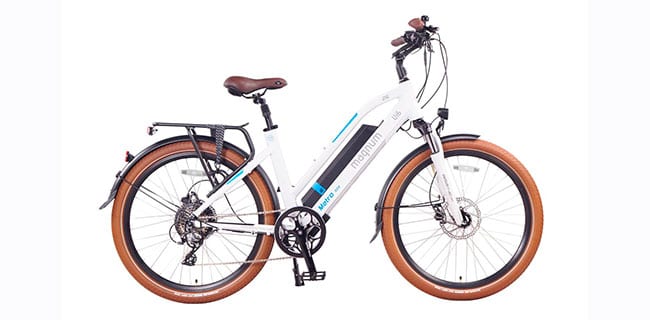With the fast-approaching holiday season, electronic bicycles, or e-bikes, are the perfect festive gift for any of your friends or loved ones. Over the years, electric bikes have quickly become the hottest trend in alternative transportation options.
It is believed that the first e-bike was introduced in United States during the 1890s, with the most popular model coming on the market in the 1990s. 1992’s Vector Services Limited’s Zike revolutionized the industry.
Today’s rising fuel costs, limited and expensive parking options, and endless traffic jams have left many Canadians in the major cities scrambling for new transportation and commuting options. Fortunately, finding the perfect e-bike is now easier than ever, with increased retailers available throughout Canada.
E-Bike Benefits
There are a variety of benefits to owning an e-bike. These include personal health benefits, such as being able to ride further and longer with greater ease; financial benefits, such as saving money on vehicle gas and repairs and parking; environmental and geopolitical benefits, such as reducing energy, reducing our carbon footprint, and using renewable energy sources.
E-Bike Retailer Locations
E-bikes can easily be found in many major Canadian cities, such as Toronto, Montreal, and Vancouver. They can also be found in smaller towns, such as Abbotsford, Chilliwack, Surrey, Victoria, North Vancouver, and Nanaimo, British Columbia; and Nepean, Lindsay, Guelph, Brampton, Hamilton, Brantford, Ontario. In addition, a variety of Canadian online retailers are available as well. Many conveniently offer free shipping as well.
E-Bike Class Divisions
E-bikes are divided into 3 main classes, Pedal-Assist/Pedelec, Throttle, and Speed Pedelec.
- Class 1: Pedal-Assist/Pedelec (Pedal Electric) is the most common type of e-bike. The motor provides assistance to the rider pedaling, making riding much easier and requiring less effort. Because it does not go faster than 32km/hour, it can be used on the same roads and paths as regular bicycles, and does not require extra licensing.
- Class 2: Throttle is similar to a scooter or motorcycle. Unlike Class 1, these types of e-bikes are propelled without assistance from the rider. They do not require special licensing.
- Class 3: Speed Pedelec is similar to Class 1, only much faster. They can reach 45km/hour. Riders often need licenses for these types of e-bikes. At times, they are restricted from certain paths.
E-Bike Types
E-bikes can be also divided into 2 main groups, depending on the location of their motor, namely Hub Motor and Mid Drive E-Bikes.
- Hub Motor E-Bikes consist of direct drive hub and geared hub motors. These motors are located on either the front or rear wheel.
Direct Drive Hub Motor E-bikes are larger, faster, and more durable. However, they are known to have less torque and are much heavier.
Geared hub motors are smaller and lighter, with greater speed, but less torque.
- Mid Drive E-Bikes incorporate the motor into the frame or bottom bracket. These tend to have a better weight distributing than hub motors and are easier the repair.
A third option exists as well. Regular bikes can now be retrofitted to electric assist. Many retailers offer conversion kits, which can turn almost any type of regular cycle into an e-bike. The most common kit is the hub motor conversion kit; however, mid-conversion kits are also popular. The newest innovation are all-in-one wheel kits, which place the motor, battery, and controller in a hub or wheel.
E-bikes can be further broken down into electric-assist mountain bikes for going further and faster than ever before, and electric hybrid bikes, which are perfect for amplifying one’s pedaling power in the city.
E-Bike Additional Information
According to federal and provincial regulations, e-bikes run up to 32km/hour. Depending on battery type, rider weight, weather, speed, and level of pedaling, e-bikes can last up to a distance of 25-100km. Most batteries take about 6 hours to charge.
Best of all, under the Canada’s 2000 Motor Vehicle Safety Regulations, many often to do not require any sort of special licensing. Federal law states that that provinces and municipalities are responsible for restrictions. Therefore, riders must consult their provincial laws for detailed information. For example, in British Columbia riders must be at least 16 years of age and wear a helmet. In Alberta, the age is 12, while in Ontario it is also 16. In addition, e-bikes are not permitted on 400-series highways and cannot exceed speeds of 32km per hour.
Cost of E-Bikes
In Canada, the cost of e-bikes ranges from $3,000 CAD for basic models and upward of $25,000 CAD for professional, high-performance e-bikes.
Additional Services
Along with e-bikes, many stores also offer apparel, tires, wheels, helmets, saddles, and footwear as well.
The perfect e-bike can easily be found just in time for the holiday season. Do not hesitate to contact the various Canadian e-bike vendors in your area, or online.
This content is a joint venture between our publication and our partner. We do not endorse any product or service in the article.

